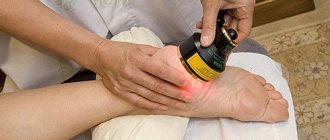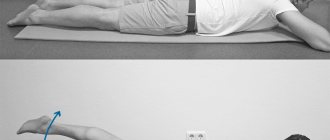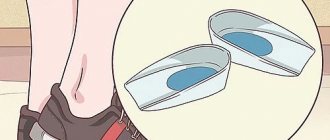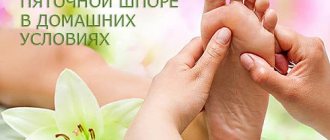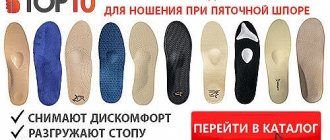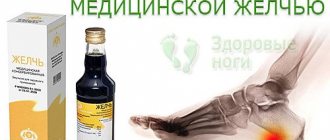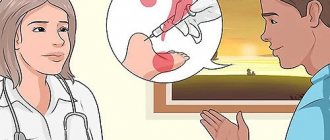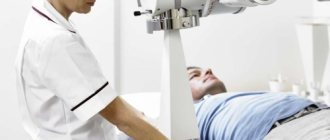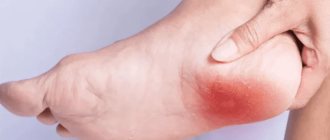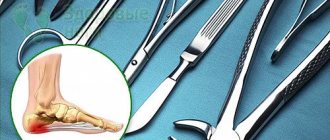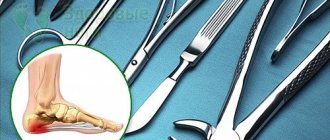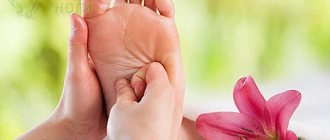Magnetotherapy (16) Infrared and phototherapy (10) Vibroacoustic therapy (6) Laser therapy (4) Quantum therapy (2) Thermotherapy (3) Electrophoresis and Galvanization (5) Electrical stimulation (3)
Magnetic therapy for heel spurs is prescribed to stimulate decongestant and anti-inflammatory processes, reduce pain, and accelerate recovery after heel surgery. The therapeutic factor of magnetic therapy is the effect of a magnetic field on the heel area. It can be constant or variable.
Exposure to a magnetic therapy device leads to the following effects:
- improving blood circulation due to dilating blood vessels;
- the formation of weak currents in body tissues, which positively affect the structure of proteins;
- reducing pain and inflammation;
- improving vascular permeability.
If you experience pain in one heel, the electrodes of the device are placed in the lumbar region and on the painful area.
It is recommended to conduct sessions for 10-12 days, duration - from 5 to 8 minutes. If heel spurs have developed in both heels, electrodes are placed on both painful areas and on the lower back. The course of treatment in this case is up to fifteen procedures.
The main advantages of magnetotherapy treatment for heel spurs:
- the skin in the affected area is not irritated;
- no pain;
- possibility of home procedures;
- good result in the initial stages of the disease.
This physiotherapeutic method is not used for recent heart attacks and strokes; inflammation with pus; bleeding tendency; pregnancy; vascular aneurysms; low blood pressure; arrhythmias; presence of tumors.
Magnetic therapy devices for the treatment of heel spurs
[td]
Additional physiotherapy for heel spurs
When prescribing treatment for heel spurs, physiotherapy should solve specific problems; doctors often recommend additional methods of physiotherapy.
These methods are not generally accepted, but their effectiveness in combination with traditional procedures is beyond doubt.
Such additional physical procedures include:
- Magnetic therapy for heel spurs. Exposure to magnetic fields stimulates blood circulation, accelerates metabolism, and eliminates swelling.
- Ultraviolet irradiation. Promotes tissue renewal, has a beneficial effect on nerve endings.
- Mud therapy. Mud wrap helps relieve acute pain, reduce inflammation, and has a warming effect
- Paraffin treatment. “Paraffin boots” have a resolving effect and relieve pain symptoms.
- Hydrotherapy: baths, mineral waters, circulation showers. Improve metabolic processes and have a strengthening effect.
- Massage for heel spurs. Helps to relax and release fascia clamped by a spur, improves lymph and blood flow in the extremities.
After relaxing procedures, it is advisable to tap the foot with a heel spur in order to fix the heel fascia in a stretched position, which contributes to their recovery.
Electrophoresis for heel spurs
Electrophoresis is a hardware method for transferring active pharmaceuticals with analgesic and anti-inflammatory effects to affected tissues. This effect occurs under the influence of a weak electric current.
Unlike other physiotherapy procedures, treatment of heel spurs with electrophoresis has a prolonged effect - drug ions can accumulate in tissues and have a long-term effect.
If your heel spur hurts very badly, physical therapy with hydrocortisone will help relieve pain after the first procedure.
The following medications are used for electrophoresis:
- painkillers in the form of solutions: novocaine, lidocaine, etc.;
- anti-inflammatory drugs: salicylic acid, nimisulide, demixide;
- drugs that absorb spurs: potassium iodide, medical bile;
- steroids: hydrocortisone.
Electrophoresis is carried out as follows: the heels are smeared with the desired preparation and electrodes are applied to them. After turning on the device, an electric current of 5-20 mA is supplied, under the influence of which drug ions are delivered deep into the connective tissue.
The choice of pharmaceutical drug is made only by the doctor and depends on the patient’s condition. As a rule, painkillers are used for the first 1-2 procedures, and then anti-inflammatory and absorbable agents are used alternately.
The duration of the electrophoresis session is 10-20 minutes. The procedure is carried out every other day or every day at least 10 times.
Phonophoresis for heel spurs
Ultraphonophoresis or phonophoresis is one of the best procedures to alleviate the condition of a patient with fasciitis. The procedure combines elements of UHF and electrophoresis - medicines, incl. steroids are delivered to the affected tissues deep into the fascia of the heel using ultrasound waves.
Ultrasound waves relieve spasms and inflammation, which leads to a reduction in pain. The drugs used are similar to those used for electrophoresis.
Phonophoresis with hydrocortisone for heel spurs is a complete replacement for the blockade and helps eliminate excruciating pain that does not allow a person to lead a normal life.
This procedure goes well with modern treatment of heel spurs, which is practiced in public and private clinics.
During phonophoresis, a drug is applied to the heel instead of ultrasound gel. Ultrasound therapy for heel spurs is performed with a frequency ranging from 600 to 3000 kHz. The radiation intensity is controlled by a physiotherapist.
The choice of medication should be made only by the attending physician, and adjustments are made to the medication regimen to avoid overdose.
X-ray therapy for heel spurs
X-ray therapy is a method of physical treatment that uses X-rays of 10-250 square meters. Low-dose radiation actively affects the spur and blocks the nerve endings, eliminating pain.
Also, treatment of heel spurs with radiotherapy has an anti-inflammatory effect and promotes rapid restoration of damaged fascia through the use of radioactive microdoses of 20-80 rads.
The radiation source is an X-ray tube aimed directly at the center of the spur. This method does not eliminate the growth, but effectively fights other manifestations of the disease: inflammation, infection of the thorn, pain, swelling.
Attention! X-ray therapy has many contraindications and is prescribed only when other methods of physical treatment have not brought a positive result. This method is considered a last resort before surgery and is only used for patients over 35 years of age.
To consolidate the positive result, it is necessary to properly care for your feet, avoiding injury to the heel fascia. For this purpose, insoles for wearing spurs and comfortable shoes are required.
UHF for heel spurs
During the session, the UHF device creates an electromagnetic field, which becomes a source of high-frequency alternating current directed to the inflamed fascia.
By acting on tissue, UHF increases blood supply and metabolism, reduces the intensity of pain, and promotes relaxation of fascia clamped by a bone spike.
By increasing the permeability of blood vessels and capillaries, the production of local immunity is enhanced, and the process of regeneration of connective tissues is launched. UHF therapy is absolutely painless and has no side effects.
The procedure is performed in a lying or half-sitting position. Metal conductor plates are placed on the patient's feet through which an electric current will pass. The duration of UHF exposure is 10-15 minutes. The doctor prescribes the number of procedures, taking into account the severity of pain and the patient’s condition; as a rule, the course consists of 12-15 sessions.
Orthopedic doctors strongly recommend combining UHF therapy with physical therapy for heel spurs. Together, these two methods of treating fasciitis perfectly strengthen the fascia of the heels and restore their normal functioning.
At night, to speed up the regeneration of fascia on the heels, it is recommended to use a Strasbourg sock, which fixes the foot in a stretched position.
Night orthoses for heel spurs have the same property, but in comparison with them, the Strasbourg sock is easier to use, and its effect is much more effective.
Contraindications to physical therapy
Despite its high effectiveness, each physiotherapy procedure has its own list of contraindications. When prescribing a treatment course, the doctor will necessarily take into account the characteristics of the patient’s body and health status.
Absolute contraindications for most physiotherapeutic procedures are:
- hypertension in the acute phase;
- oncology;
- acute infectious diseases;
- bronchial asthma in the acute stage;
- foot injuries;
- blood coagulation disorder;
- some forms of diabetes;
- wounds on the feet.
In these cases, physical therapy will have to be postponed until the condition normalizes.
Physiotherapy for heel spurs to remove the growth
The physiotherapy procedures described above perfectly eliminate pain and reduce inflammation, but have no effect on the spur. However, there are two types of physical therapy that can eliminate heel bunions non-surgically. This is laser therapy for heel spurs and shock wave therapy.
Laser therapy (quantum therapy) is of two types:
- low-frequency laser exposure aimed at reducing pain, swelling and improving tissue regeneration;
- high-frequency quantum radiation, with the help of which the spur is crushed.
High-frequency laser therapy can replace surgery and completely remove the bone-saline spine. The course of quantum therapy includes 2-3 stages of 10 sessions. Between stages there is a break of 2 weeks.
Shockwave therapy removes the spur by breaking it up with sonic shock waves. During the treatment of heel spurs with shock wave therapy, the growth gradually loosens and resolves.
To enhance the effect, it is recommended to use Pyatkashpor cream with medical bile after the session, which also helps reduce spurs.
The UVT course consists of 10-15 procedures, 20 minutes each. The effectiveness of laser therapy and shockwave therapy is 90%, which is comparable to surgical treatment of fasciitis.
It is also recommended to do gymnastics, follow a diet and eliminate the cause of the spur - flat feet and other deformities of the limbs.
